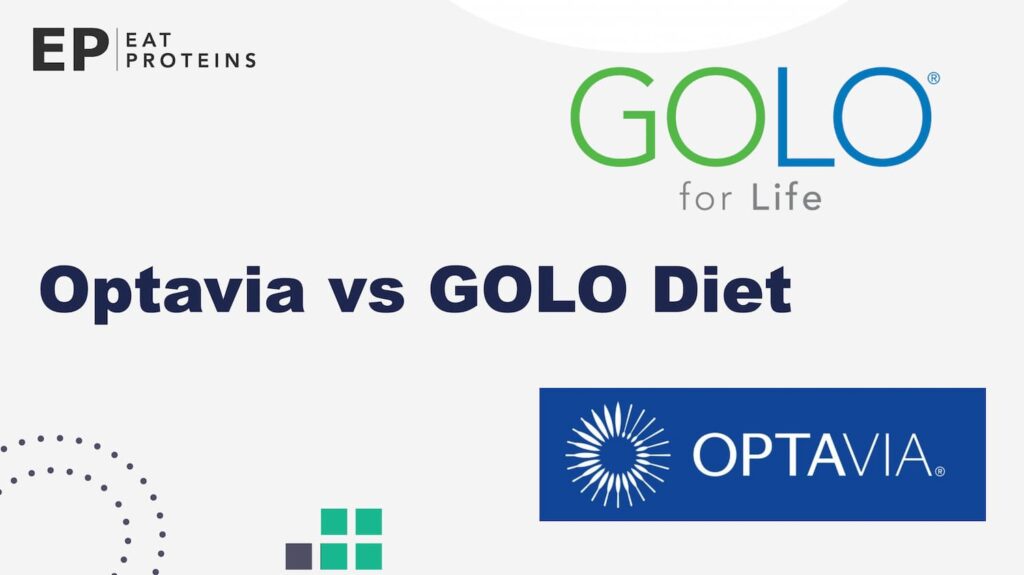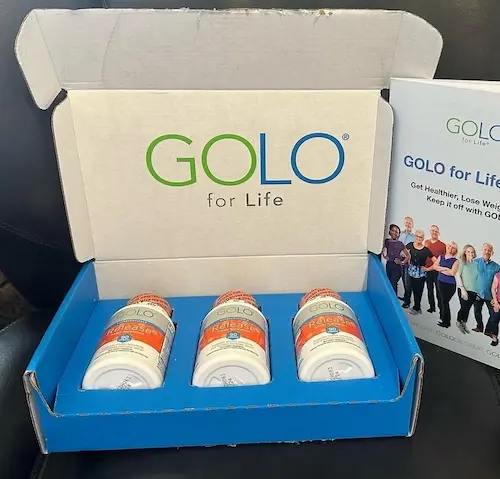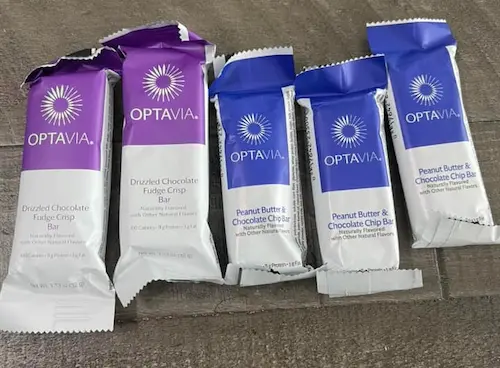
I’ve tried both Optavia and GOLO diets and there are some differences in their approach to weight loss. Optavia offers meal replacement shakes, bars, and low-calorie meals, plus coaching and an online community. GOLO’s more traditional with meal plans, recipes, and their GOLO Release supplement, which they say improves insulin resistance. Here’s a closer look at Optavia vs GOLO – their prices, products, effectiveness, customers’ thoughts, and alternatives to help you decide which suits you better.
EatProteins.com is a reader-supported platform. Purchases made through our links may earn us a commission at no extra cost to you.
An overview: Optavia versus GOLO
Here’s a table comparing the Optavia and GOLO diets.
| Optavia Diet | GOLO Diet | |
|---|---|---|
| Convenience | No cooking is needed. | Requires cooking from scratch. |
| Weight Loss | Potential for rapid results. | Not focused on quick loss; no calorie counting. |
| Cooking Requirement | No cooking needed. | Cooking is a must. |
| Sustainability | Questionable long-term viability. | Promotes sustainable eating habits. |
| Food Quality | Processed foods; possible allergens (nuts, dairy). | Focus on whole foods. |
| Cost | $471.85 per month | $40-$60 per month |
| Health Approach | Convenient but processed. | Encourages exercise and balanced eating. |
What is the GOLO diet?
The GOLO Diet is a weight loss plan focusing on controlling insulin levels to help you lose weight. It consists of a 7-day meal plan and Release supplements. The meal plan encourages healthy eating with lean proteins, nuts, avocados, veggies, and whole grains. The GOLO Release is a supplement taken three times a day with meals, containing ingredients like Apple extract, Banaba extract, Rhodiola, Berberine extract, Gardenia extract, Inositol, Salacia extract, Chromium, and Magnesium.
In a 3-month study funded by GOLO, LLC and led by Robert J Buynak, 68 overweight individuals with insulin issues followed the GOLO program with the Release supplement. The results showed that they lost more weight and had improved health markers, like smaller waists and lower triglyceride levels. They controlled their daily food intake based on their metabolic rate calculations and exercise.
What Is the Optavia Diet?
Optavia is a weight loss program related to Medifast. It involves eating small pre-packaged meals called “Optavia Fuelings” every few hours and having one homemade “lean and green” meal each day. The Fuelings are around 100-110 calories and include soups, bars, shakes, and desserts. The “lean and green” meal consists of lean protein like fish or chicken and non-starchy veggies, keeping it under 400 calories.
A study funded by Medifast Inc. in 2019 found that the Optavia 5&1 Plan and phone coaching led to much better results than people trying a self-directed diet. Those on Optavia achieved a weight loss of over 10% of their body weight, while the self-directed group only managed 1.6%.
Optavia vs GOLO: What’s the difference?
I tried Optavia and GOLO, and I found differences in their prices, program structure, and supplements, as well as the types of meals they offer. However, they both share the goal of weight loss and reducing food intake to help you eat less. Their recipes, availability, and definition of a healthy lifestyle are quite similar. Optavia and GOLO also differ in weight loss results, online feedback, and brand perception, as seen in various customer reviews.
Price
I’ve been comparing the costs of the GOLO diet and Optavia, and here’s the scoop in a nutshell. GOLO’s Release supplement costs $59.95 for one bottle (30 days), $99.90 for two (60 days), and $119.85 for three (90 days), with a buy-2-get-1-free deal. Optavia’s monthly cost is steeper at $471.85 per month for their 5 and 1 plan, breaking down to $23.25 per box (7 servings) or $3.32 per serving. From my experience, GOLO is easier on the wallet, especially with their 30-day money-back guarantee, but remember, GOLO prices don’t cover your regular groceries.
Supplements
The GOLO diet supplement boasts ten active ingredients, like Magnesium, Zinc, and a special blend with Rhodiola and Berberine extracts, aimed at weight loss and glucose level management. While these ingredients are FDA-approved for safety, their effectiveness in weight loss isn’t scientifically proven yet. Here’s the photo of the GOLO Release supplement.

In contrast, Optavia doesn’t do pills; apart from Fuelings they also have Muscle Health Kits with protein shakes and Amino Acids in their Optavia ACTIVE plans.
What you can eat
The Optavia and GOLO diets both focus on lean proteins (like chicken, turkey, fish, eggs, and cottage cheese) and non-starchy vegetables (such as salad greens, cauliflower, and broccoli). They agree on moderate intake of healthy fats and complex carbohydrates. Key differences? Optavia includes meal replacement Fuelings and restricts high-carb starches like potatoes and rice, whereas GOLO promotes a balance of all major food groups, including these starches.
Meal plans
The GOLO meal plan advocates for three well-balanced, daily meals featuring natural, unprocessed foods, focusing on whole foods and effective diet management without relying on meal replacements. Conversely, Optavia’s approach includes six smaller meals a day: five convenient, pre-packaged “Fuelings” and one self-prepared “Lean and Green” meal. Optavia also offers an optional daily snack to help curb hunger. Here’s the photo of what you eat on Optavia diet.

After a year on the Optavia diet, I’ve found their Fuelings, such as bars and shakes, to be tasty, similar to granola bars. I’m not particularly fond of their soups or mashed potatoes. The serving size is small at 32 grams, which leaves me feeling hungry for most of the day compared to homemade alternatives.
Calories
The Optavia 5&1 Plan suggests a daily intake of 800-1,000 calories for all adults, regardless of age, gender, or activity level. For a less restrictive option, Optavia’s 3&3 Plan combines three Fuelings with three self-prepared meals, recommending 1,200-2,500 calories daily. Meanwhile, the GOLO diet advises 1,300-1,800 calories across three meals daily, but its specific meal plan is available only with the purchase of its Release supplement.
Recipes
Optavia and GOLO both offer great recipe options, but they cater to different tastes. GOLO boasts a diverse menu including breakfast, lunch, snacks, desserts, and even bread – think Homemade Turkey Chorizo and Blueberry Breakfast Quinoa. On the other hand, Optavia focuses on dinner, especially lean and green meals. Each dish packs 30-40 grams of protein with less than 15 grams of carbs, making it a solid choice for a low-carb diet.
Where to buy
Optavia products are exclusively sold through their website and require pairing with an independent Optavia coach. However, you can sometimes find their products on eBay or through private sellers in Facebook groups. On the flip side, GOLO’s Release supplements are more widely accessible; they’re available both on their website and in Walmart stores.
Weight loss results
According to our dietician, both the GOLO and Optavia diets can lead to weight loss, but they take different approaches. The GOLO diet emphasizes a balanced diet with fruits, vegetables, and lean proteins, sticking to the classic weight loss strategy of reducing calorie intake and opting for healthier food choices. However, there’s limited scientific backing for its effectiveness.
On the flip side, Optavia offers convenience with pre-packaged meals, which generally leads to lower calorie consumption. This diet includes special options for those with diabetes, featuring low glycemic foods. Be cautious with Optavia’s 5 and 1 plan though; it limits daily calories to about 800, much lower than the USDA’s recommended 2,000 calories for adults. Such extreme calorie cuts can lead to short-term weight loss but might cause fatigue and other health issues if followed long-term.
Online Reputation
Optavia has a 1.55/5 rating on the Better Business Bureau (BBB) and is not BBB accredited, with 476 complaints in three years, focusing on delivery, service, and refunds. In contrast, the GOLO diet boasts an A+ BBB rating and a higher 3.32/5 in customer reviews, though it faces issues with billing and product interactions with medications.
Which one is better GOLO versus Optavia?
Optavia, with its ready-made meals, is the right fit for you if you’re looking for rapid weight loss and prefer the convenience of not cooking. However, if your focus is on long-term sustainability and a diet rich in whole foods, the GOLO diet, which encourages balanced eating and exercise, would be a better choice. Keep in mind, that the GOLO diet involves cooking from scratch, which might be challenging if you’re short on time or not confident in the kitchen. Conversely, Optavia’s dependence on processed foods could be a concern if you have food allergies or are seeking a more natural diet. In summary, while Optavia caters to ease and quick results, GOLO is more suited to those dedicated to a holistic health approach and natural food choices.
What are some alternatives to Optavia and GOLO?
If you’re exploring alternatives to Optavia and GOLO, consider these options: For a holistic approach, the Mediterranean or DASH diets are great. Programs like Weight Watchers, Nutrisystem, and Jenny Craig offer support similar to Optavia. For partial meal replacements, Wonderslim or Slimfast are handy. If you’re okay with cooking and seek appetite suppressants like GOLO, options include Goli Gummies, Plexus Metaburn, PhenQ, or Provitalize. But if a close friend asked me for one of the best weight loss plans that is easy to follow and designed by experts, I would recommend trying the Mayo Clinic Diet.
What are the differences between Optavia, GOLO, and Mayo Clinic Diet?
Optavia, GOLO, and Mayo Clinic Diet each offer unique approaches to weight loss. Optavia uses pre-packaged meals and a coach-led model, focusing on low-calorie, high-protein options. GOLO, on the other hand, emphasizes insulin management through a balanced diet of whole foods and includes a supplement called Release. The Mayo Clinic Diet is rooted in research and promotes healthy eating habits and portion control, without specific supplements or pre-packaged meals.
How does Optavia compare to GOLO and the Mayo Clinic Diet for weight loss?
When it comes to weight loss, the Mayo Clinic Diet stands head and shoulders above GOLO and Optavia with its “Excellent” rating on Trustpilot. This diet has shown results, with members reporting a loss of 6-10 lbs pounds in just the first two to three weeks. It’s backed by reputable institutions in the medical field, including Harvard Medical School, WebMD, the American Public Health Association, Healthline, and the Cleveland Clinic.

